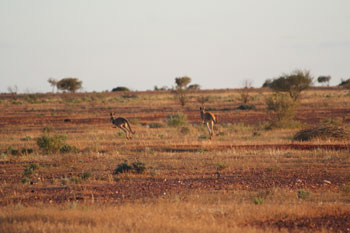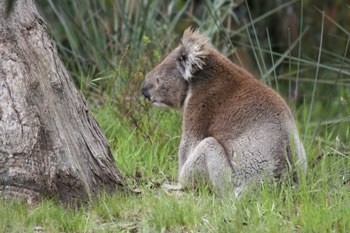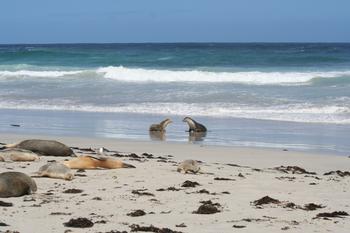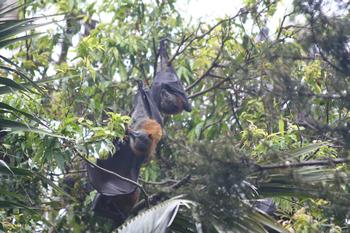| Over 90% of Australian wildlife is nocturnal, so the best time to view these native inhabitants is at night. So we saw a lot more than we were able to photograph, and we didn't even see a lot more. On the night we were out with Jeff they were so plentiful that we resolved not to drive at night if we could help it—the chances of hitting one were far too great. Most of these pictures are therefore shot under extremely poor light conditions and many are also under some other constraint like weather, haste, or shot-from-the-hip-while-on-the-move. |
Marsupials
|
 |
 |
|
The need to be able to survive tough times favoured animals with lower metabolic rates – reptiles and marsupials. There are still over 100 spp of marsupials, which are now protected in sanctuaries as well as continuing to flourish in their natural environment. Kangaroos have evolved as part of the Australian ecosystem and, with their soft feet, do not cause soil rosion or landscape damage on the rangelands they graze. There are 55 different spp of macropods—kangaroos, wallabies, wallaroos, pademelons, tree-kangaroos and forest wallabies—native to Australia. Macropod species vary greatly in size and weight, ranging from half a kg (1.1 lb) up to 90 kg (200 lb).
Australia’s native marsupials have a different chromosome structure than mammals in other parts of the world. Typically, they suckle their young in a pouch. Marsupials occupied a wide range of ecological niches in Australia. The first kangaroo marsupials seem to have appeared about 15 million years ago. They vary enormously in size and adaptation. A species of tropical kangaroo lives in trees, but most kangaroos are tough, efficient users of dry bush. |
|
 |
|
 |
|
| Macropods |
Tammar Wallaby

|

|
| |
Bennett's Wallaby

|

|
| |
Red-necked Wallaby |
|
| |
 |
 |
|
Red Kangaroo
Australia's Kangaroos
Kangaroos are native to the Australian continent and to parts of Papua New Guinea. Most species are only found in Australia. There are over 60 different spp of kangaroo and their close relatives. All kangaroos belong to the superfamily Macropodidae (or macropods, meaning“great-footed”). The macropod family includes kangaroos, wallabies, wallaroos, pademelons, tree-kangaroos and forest wallabies. These species are also found in Papua New Guinea. Species in the macropod family vary greatly in size and weight, ranging from 0.5kg (1.1lb) to 90kg (200lb). The Potoroinae (potoroid) family of kangaroos includes the potoroo, bettong and rat-kangaroo. This family of kangaroos lives only in Australia.
Kangaroos of different types live in all of the diverse areas of Australia, from cold-climate rainforests and desert plains to tropical areas. They are herbivorous, eating a range of plants, and in some cases fungi. Most are nocturnal but some are active in the early morning and late afternoon. Different kangaroo species live in a range of different environments. Potoroids, for example, make nests while tree-kangaroos live above ground in trees. Larger species of kangaroo tend to shelter under trees or in caves and rock clefts. Kangaroos of all sizes have one thing in common, powerful back legs with long feet. Most kangaroos live on the ground and are distinguished from other animals by the way they hop on their strong back legs. The kangaroo's tail is used to balance while hopping and as a fifth limb when moving slowly.
All female kangaroos have front-opening pouches, which contain four teats. This is where the “joey” or young kangaroo is raised until it can survive outside the pouch. Most kangaroos have no set breeding cycle and are able to breed all year round. Because they are such prolific breeders, a kangaroo population can increase fourfold in five years if it has continuous access to plentiful supplies of food and water.
|
|
 |
|
 |
|


 |
| |
 |
 |
|
Western Grey Kangaroo
Kangaroo management and use – Kangaroos have long been important to the survival of Australia's Indigenous peoples. Aboriginals have hunted kangaroos for tens of thousands of years, for both the meat and the skins. When Europeans arrived in Australia in the late eighteenth century, they too hunted kangaroos for survival. Kangaroos continue to be used as a resource but only under strict government controls. All Australian States and Territories have legislation to protect kangaroos. Only the four most abundant species of kangaroo and small numbers of two common wallaby species can be commercially harvested, and then only by licensed hunters.
The commercial harvesting of widespread and abundant kangaroo species contributes to the sustainability of the Australian environment.
The red kangaroo, Eastern grey kangaroo and Western grey kangaroo are the most abundant species and make up over 90% of the commercial harvest. Their combined population size has fluctuated between 15 and 50 million animals over the past 20 yr in the harvested areas, depending on seasonal conditions. There is no farming of kangaroos in Australia. Kangaroos are harvested in the wild by licensed hunters.
The Australian kangaroo industry estimates that it exports kangaroo meat to more than 55 countries. Kangaroo meat is increasingly popular, and export markets are expected to increase. It is considered one of the finest game meats. Its growing appeal stems from its well-flavoured, slightly gamey taste. Kangaroo meat contains very little saturated fat relative to other meats and is high in protein, zinc and iron. The European Union and Russia are the most significant markets with the USA and Asia becoming increasingly important. |
|
 |
|
 |
 
|




|
| Other Marsupials |
 |
 |
|
Koala (Tasmanian)
Koala – Is it koala bear? No, it’s just koala. A common myth is that the koala is a bear. While at times in the past it has been referred to as the native Australian bear, koalas are no relation to the bear family at all. In fact they are marsupials. Koalas enjoy a relaxed lifestyle and can be most often seen sleeping high up in the forked branches of trees in the daytime. It is not uncommon for a koala to sleep up to 20hr a day due to its low-energy diet. These nocturnal tree dwellers eat the leaves of just a select few species of Australian eucalypt trees.
A baby koala measures about 2cm long when it is born. Even at this little size they can still find their way to their mother’s pouch. Here they stay for about six months before venturing out into the world—although they will still catch a ride on mum’s back for several months after that.
Koalas can be spotted in national parks and forests along the east coast of Australia. Wildlife sanctuaries allow visitors to observe animals from close range and some zoos even allow visitors into animal enclosures. |
|
 |
|
 |


|


 |
| |
Tasmanian Devil
The
Tasmanian Devil, a carnivorous marsupial, is a fascinating animal now only
found in the wild in Tasmania. |
 |
| |
 |
 |
|
Wombat
The wombat is a large, grazing, burrowing marsupial. Essentially nocturnal, wombats have been in Australia for 15 million yr and are found in many parts of Australia.
The wombat is no small animal, at about a metre long it can weigh up to 40kg. With dense dark brown fur, strong limbs and sharp claws, it can be a powerful adversary for preying animals. The wombat’s sharp claws are a tool of survival. They are used in daily life for digging underground tunnels up to 20m long
where they sleep and nest. Living mostly in wooded coastal areas, the wombat likes to build its tunnel near creeks and rivers where they will have easy access to food and water. |
|
 |
|
 |
|
|
| Monotremes |
 |
 |
|
As well as marsupials, Australia hosts another unique animal group, the monotremes – egg-laying mammals, which are often referred to as 'living fossils'. Perhaps the most distinctive is the platypus - a river-dwelling animal with a duck's bill, a furry, otter-like body and webbed feet. Another representative of this group is the echidna or spiny ant-eater.
Echidna – Also called Spiny Ant Eaters, echidnas are found throughout Australia and Papua New Guinea and are covered in coarse hairy spines all over the back and legs. Their long skinny snout is used to forages for food under rocks, in termite mounds and ant nests. The echidna has a long sticky tongue that it rapidly shoots out to gather up a number of ants at a time.
A monotreme, the echidna lays eggs like a platypus, but incubates and nurtures its hatched young in a pouch like a marsupial. Baby echidnas stay in the mother’s pouch for about six weeks, after which it will leave, but stay quite close by its mother until capable of looking after itself. |
|
 |
|
 |

|


|
| |
|
Our brief and dark encounter left us with no pictures. But there are plenty of resources on the Web. This one is excellent. |
| Sea lions |



|




|
| New Zealand Seals |


|



|
| Fruit Bats |
|
|
| |
 



|





|
|










































